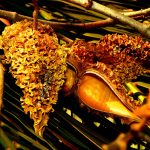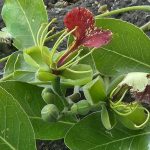 TREE LIFE 531
TREE LIFE 531
NOVEMBER 2024
FUTURE EVENTS
PLANNED EVENTS:- NOVEMBER
Since inclement weather or other issues may vary our plans, WhatsApp Tony Alegria on 0772 438 697 to join our WhatsApp group for last minute updates.
Saturday 2nd November 2024:- visit to the National Botanic Gardens. We are pleased to have 2 new joint leaders for this event, Ann Sinclair and Jan van Bel, who will shed a different light on visits to the gardens.
Main meeting Sunday 17th November 2024:- We will be visiting Patrick Mavros’ Mpata Farm in Umwinsidale. Our last visit was in July of 2022 so we expect to see the same trees with lots of leaves and perhaps flowers. We aim to start botanising at 9.30am and details of logistics re sharing transport via WhatsApp later..
Directions: There are 2 possible routes, either take the Nyamapanda Road (old Enterprise Road) out of town and just past the Umwinsidale Service Station turn left into Umwinsidale Road; after about 4 km take the right hand fork into Hazelmere Lane. Alternatively, take Liberation Legacy Way (old Borrowdale Road) out of town and turn right into Crowhill Road; after 6.3km (past Heritage school and the Brook) turn right onto Luna Way; after 3.2 km turn right onto Umwinsidale drive and after 1.8 km take the left-hand fork onto Hazelmere Lane. After about 500m the road turns right and the Patrick Mavros Studio is about 500m further on at the end of the road. Google maps quotes the driving time as 30 minutes, but it may take a bit longer.
REPORTS FROM PREVIOUS OUTINGS
Saturday 28th September 2024:- visit to Athol Evans
Write-up and photos by Mark Hyde
On a very hot afternoon (maximum temperature of 33 degrees), a group of about 12 residents, including Vic Gifford and Lorraine Regadas, plus Ann Sinclair and myself met at Athol Evans Complex on the Chiremba Road for a walk to look at the trees.
Athol Evans lies on the northern side of the Chiremba Road adjacent to the Mukuvisi Woodlands. The vegetation type of the Mukuvisi is sandy miombo woodland and this is true of the area on which Athol Evans was built. Thus classic species which are common in the Mukuvisi were found, namely Burkea africana and Monotes glaber, the Pale-fruited Monotes.
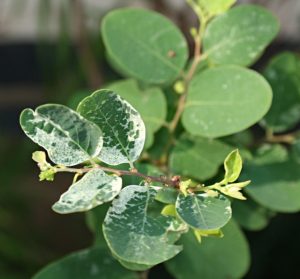
Breynia disticha
Residents had reported a potato smell in the evening so our first task was to try and track down a tree giving off this smell. Could there be a Phyllanthus reticulatus, that characteristic species of low-altitude rivers, lurking somewhere? We did not find that species, but we did find the related Breynia disticha, the Snowbush. This species, native to New Caledonia and Vanuatu, is grown for the distinctive splashes of white and sometimes pink on the leaves. This is another member of the family Phyllanthaceae, but sadly this does not give off a potato smell.
We looked at a range of trees to understand the different types of leaf. The 2-pinnate leaf examined was Albizia gummifera with its rectangular leaflets and main vein running diagonally across the leaflet. The 1-pinnate leaf example was of a Fraxinus (an ash). For simple leaves we looked at the yellow leaves of the Duiker berry, which as we know, has one of the longest Latin names Pseudolachnostylis maprouneifolia.
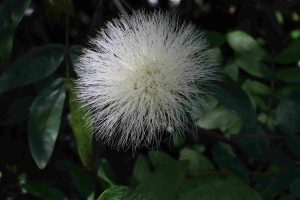
Calliandra haematocephala cv ‘Alba’
A very attractive flowering tree, planted by Dr Robin Cowper, the Chairman of the Trustees of Athol Evans, was Calliandra haematocephala, the Red powder puff. This particular tree was a white flowered cultivar (cv ‘Alba’) which had large flower heads comprising numerous stamens. This is another plant with 2-pinnate leaves but a rather undeveloped one with only 2 pinnae. It is native to Bolivia and hence not indigenous.
Species of Calliandra are similar to species of Albizia but differ in usually being shrubs (trees in Albizia) and in having pods which open from the apex downwards (along their length in Albizia) with a thickened margin (margin not thickened in Albizia).
Behind the main buildings is a fine patch of large msasas. It is very nice to see them being preserved within the city.
During the walk, many of the species seen were typical of Harare gardens: Avocados, Frangipani, Mangos, Khaya anthotheca (Red mahogany), Spathodea campanulata (African tulip tree), Ligustrum lucidum (Glossy privet) and Heptapleurum actinophyllum (this is the new name for the Queensland umbrella tree, formerly known as Schefflera actinophylla).
A striking, red-flowered climber seen was Amphilophium buccinatorium (Mexican blood trumpet). This belongs to the Bignoniaceae, the same family as jacarandas. There are relatively few indigenous species in this family but there are numerous cultivated species, often climbers with spectacular flowers.
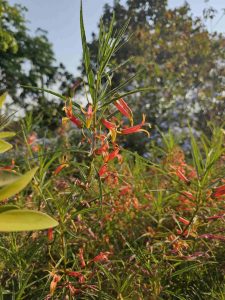
Lobelia laxiflora
Towards the end of the walk we visited two specific gardens. One was that of Mrs Hotchkiss who had an unknown shrub. This had flat-topped inflorescences of small white flowers which were reported to have an unpleasant smell and with prominent red buds near the branch apices. This was a species of Photinia (Rosaceae). The species is uncertain, possibly Photinia glabra.
Vic Gifford’s garden gave us various more unusual plants, namely a succulent, Monadenium elegans (now renamed to Euphorbia biselegans) and a beautiful scrambling species, Lobelia laxiflora.
At the end the attendees were very kindly served with tea, sandwiches and cakes courtesy of the Athol Evans Complex, for which many thanks.
Saturday 5th October 2024:- National Botanic Garden Outing
As mentioned in the previous edition of Tree Life, this event was cancelled as a large number of regular members were taking part in the exciting expedition to the Matabele region of Zimbabwe. You can read all about this in this and the next issues of Tree Life.
Sunday 20th October 2024:- visit to Doon Estates
By Linda Hyde Photos by Mark Hyde
This was a very pleasant and social visit as well as being full of trees. Tony Alegria, Mark Hyde, Jan Van Bel, Ann Sinclair, Jim Dryburgh, Vic Gifford, Lorraine Regadas and Busi Malunga and I were met by the manager, Marcey Mushore-Guthrie and sculptor Nicholas Kadzungura. Nicholas has taken on the task of tree labelling for the benefit of the school and other interested parties who visit the estate which contains the well-known Chapungu Sculpture Park.
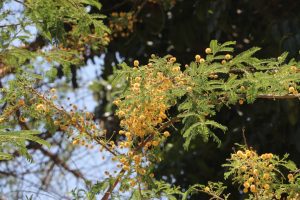
A Conundrum tree
Nicholas’ task is immense as we identified over 50 trees requiring labels, so in the interests of providing details of this visit I am limiting it to a few of those seen. The first was a Conundrum tree. At first glance its flat top, the ‘twiggy’ appearance and the long narrow leaves all suggested Acacia abyssinica but the flowers were yellow! This should however have white spherical heads! A problem now for the experts so we moved on.
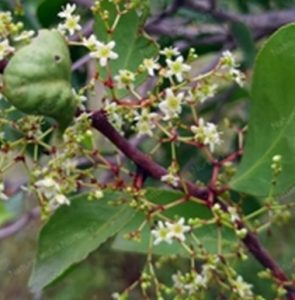
Gymnosporia
senegalensis
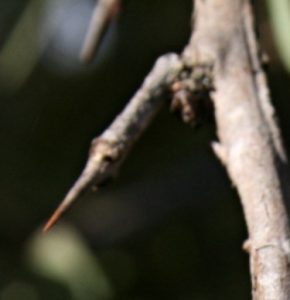
Red Thorn of the confetti tree
The Gymnosporia senegalensis is also known as the confetti tree or red spike-thorn and under many names in Shona such as Chivhunabadza and Chizhuzhu. Why? Well firstly it was originally described from a sample collected in Senegal, secondly for the thorns with a red tip, and thirdly for the delicate white flowers. Other features are the young branches which are distinctly red, while the blue-green leaves are often notched at the apex, have rounded teeth and are spirally arranged, sometimes on the spines.
We found 5 species of Ficus, firstly 3 figs of with similar features were:
Ficus sur, a well-known fig with a smooth grey/brown bark and fruits in large clusters on the trunk;
Ficus sycomorus subsp. gnaphalocarpa with a yellowish bark, the fruits are borne singly at the end of the branchlets;
Ficus sycomorus subsp. sycomorus with a yellowish, smooth, flaking bark and fruit in small clusters on the main stem.
We also found Ficus burkei and Ficus natalensis subsp. graniticola. Ficus burkei is probably the commonest indigenous fig in the Harare area and there were several fine examples seen at Doon. The leaves are usually elliptic or obovate and have an acute apex. Hairiness is very variable; leaves and fruit vary from densely hairy to hairless.
On examining closely another Ficus burkei we suddenly realised that it was in fact Ficus natalensis subsp. graniticola. This differs in having leaves with a more rounded apex which may even be notched or truncate. This subspecies was only named fairly recently (in 2003) by the well-known ex-Zimbabwean botanist John Burrows.
What was exciting was to see all 5 species in a small area.
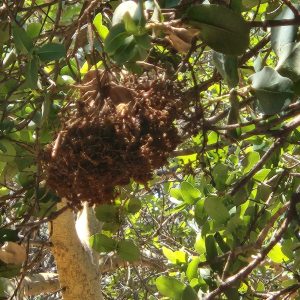
Syzygium cordatum with galls
My final tree for this article is Syzygium cordatum with galls. The word Syzygium is derived from the Greek word “suzugos” which means joined, referring to the opposite leaves. The specific name cordatum is from the Latin word cordatus, meaning ‘heart-shaped’ and refers to the shape of the base of the leaf.
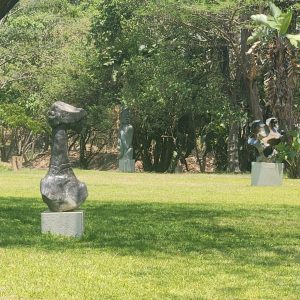
View at tea time
We were treated to a very welcome cup of tea served with the most amazing gingerbread baked by one of the commercial tenants who are based at Doon Estates and enjoyed the pleasant view from the shady veranda before the enthusiastic botanists set off again to find more wonders. I can thoroughly recommend this venue, advertised as Chapungu Sculpture Park, for a family picnic, a birthday party or wedding, a choir concert, lessons in sculpting in stone and indeed for the sculptures and trees – test yourself by trying to find the 5 figs above.
And now for the notes from
our Matabeleland Expedition
To the Matopos and beyond…. Wednesday, October 2 – Thursday, October 10
By Tony Alegria
So, we were going to have an extended tree outing to places many of us hadn’t even heard of and of course that is the reason why it was so attractive. Many members wanted to go but due to whatever unexpected events that happened, some had to pull out. However, we still had a good number attending – 19, which is a big group to cater for. Not only did Frances Morris organise the whole trip to two destinations, she also catered exceedingly well for the whole group. If anyone went hungry, it was definitely their fault – in fact, I would be surprised if anyone didn’t gain a bit of weight!
We left at 10:00 am after the morning traffic and six hours later, after a few comfort stops we refuelled in Bulawayo. We then headed out to the Matopos National Park and turned left into a dirt road fairly close to the entrance to the Park with the instruction to keep left at every fork in the road. This was rather a slow ride as many rocks had to be avoided and the going quite rough in places. We then turned right at the T-junction, this road was very wide and it was much more comfortable to ride in the donkey cart tracks, where they existed, as they were much smoother. We were the last to arrive at Camp Dwala.
Whilst a few members camped, most of us shared accommodation in big rooms with twin beds and a spacious bathroom – no bath, just a shower which worked very well.
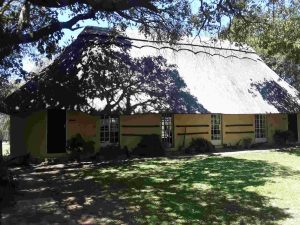
The meeting place
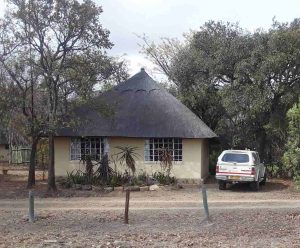
Our accommodation
Photos by Tony Alegria
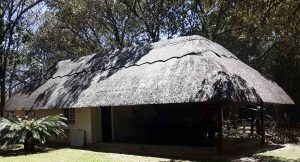
The cookhouse
There were a huge number of Parinari curatellifolia. Mbola plum trees at the Camp Dwala and surrounds resulting in huge numbers of Black-eyed Bulbuls (Toppies) being present eating the fruit along with vervet monkeys and bats. Also seen were birds I considered to be specials as they are not often seen – Mocking Chat, Familiar Chat and White-throated Robin. Very few birds were seen elsewhere within the area.
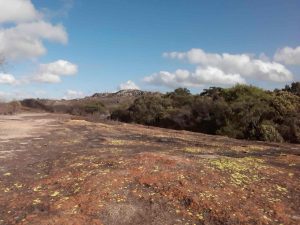
Typical “Whaleback rock” with rocky outcrop in the distance
The location appears to be the southern extension of the Matopos National Park with many dwalas (whaleback rocks or hills) and rocky outcrops. During the rainy season, the runoff from the dwalas add significantly to the amount of water available to the trees below. It is very scenic and quite a site with the many mis-named Mountain Acacias (Brachystegia tamarindoides) coming into new leaf – various shades of red were eye-catching resulting in many photos being taken. The trees are not acacias and they live in rocky places not mountains!
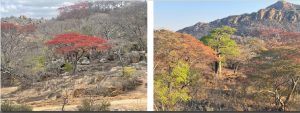
Brachystegia tamarindoides (Mountain Acacias) coming into new leaf (Photos by Stuart Wood)
We all thought Frances had organised cool weather for the trip, but she was far too efficient in doing so and we were faced with strong cold winds which the warm clothing I had taken could hardly cope with!
Peter Morris told us about this naked eye visual comet that could be seen exceedingly well with binoculars early in the morning before the sun came up. Such comets with tails are pretty rare so a determined effort was made by some members to observe this heavenly object.
We rose at about 4:30am the first morning and saw that the sky was completely overcast, so back to bed we went. On the second morning, the sky was clear above and we duly assembled at the outside dining room, near the kitchen, to have coffee and rusks. We then proceeded to the dwala behind the buildings and were blown away – no, not by the sight of the comet but by the icy cold wind! On reaching the viewing point, it was clear that we would not see the comet on that morning. It was totally clouded out from the horizon to about 20 degrees high. Very few of us tried again on the third day and it looked promising as the 20 degrees of cloud had big gaps in it. Unfortunately, the gaps soon disappeared and so did our chances to see the comet on this trip. However, it will become an evening object but albeit a lot fainter as it speeds away from the Sun.
On the third night, we were given an interesting after dinner talk by the owner, Gavin Stephens on the history of the area. The next morning, we departed for the next location, Rocky Glen, which is south of West Nicholson and only about 120 kilometres from Beit Bridge. En route we stopped to look at some Bushman Paintings in Gulubahwe Cave right by the road. It involved a bit of climbing but was well worth it. Our lunch spot was under a rather big pod mahogany, Afzelia quanzensis and nearby was a fence made of Commiphora marlothii fence posts which had taken and were sprouting shoots.
We arrived at a much warmer Rocky Glen just as it was getting dark and were allocated beds in the main house, rondavels and other buildings. After we moved in, we sat around a Bush TV and watched the fire and as usual many discussions took place. It was around this fire that dinner was served – dinners always consisted of a meal followed by dessert. As I have a food stomach as well as a pudding stomach, this arrangement really suited me!
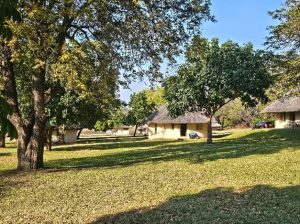
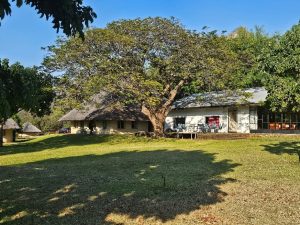
The spacious lawns of Rocky Glen with Rondavels and the main house (Photos by Mark Hyde)
The next morning, after looking for waterbirds at the dam, we botanised nearby and what soon became obvious was that at Camp Dwala there were many Mbola plums and Ficus glumosa, here they were almost absent. Whilst at Rocky Glen we were taken to see and botanise in an area with endemic Cycads, a gorge and a cave. On two evenings Bill ran a fun quiz which went down a treat. We also had Peter Morris with a telescope showing all some wonderful objects in the sky – Saturn was probably everybody’s favourite heavenly object.
On the last evening we drove onto a dwala to watch the sunset and whilst there we did a bird count for birds seen by everybody at Rocky Glen, strangely exactly 100 bird species had been seen and then we heard two nightjars calling – the Freckled and the Fiery-necked. So, total count 102!
We had our last supper around the bush TV and after the customary thank you after-dinner speech was over, were treated by something totally unexpected – Bill Clarke and Fiona Lawrence miming “Goodness Gracious Me” which was sung way back in 1960 by Peter Sellers and Sophia Loren. Fortunately, Linda Hyde recorded the act on her phone and now all our members can enjoy it.
The next morning we all departed for home, although some members stayed overnight en route.
To mark the occasion many of us have scratches and skin punctured to prove that we were in the bush, but we did have a few other incidents. The worst was Stuart Wood who after the last quiz took off in the dark towards his bed only to trip on a rock and open up his leg on a garden tap. Fortunately we had Frances Morris and Pam Woods on site to sort him out with a few stitches. The cars too suffered; Karl managed to puncture three tyres – two about fifteen minutes apart while I had my radiator pop just before Shurugwe resulting in an unplanned five hour stop!
To sum up, it was a great Tree Holiday with great people!
Outward bound – 2 October 2024
By Karl van Laeren Photos by Karl van Laeren
Camp Dwala is situated on the eastern side ofthe Matobo NP at an altitude similar to Harare at 1450 meters. The rainfall is also considerably higher than the average for Matabeleland with levels at around 850mls p.a. The camp is supplied by a borehole/well that is but 4 meters deep!
I decided to take the Old Gwanda road out of Bulawayo, the road not recommended, the attraction being that it goes via the Umzilikazi memorial erected in 1941. It took me three attempts to find the start of the road, but the effort was well rewarded.
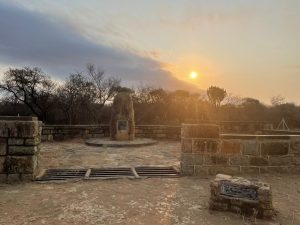
Memorial to Mzilikazi, King of the Amandabele Nation
c. 1790 – September 9, 1868
About 20 km outside Bulawayo is a large granite obelisk enclosed in a beautifully low rock walled enclosure with a simple plaque in honour of the King of the Amandabele Nation who entered the country in 1838. Lyn Mullin’s book Historic Trees of Zimbabwe had piqued my interest to see this site even though the Indaba tree is now gone, killed by unscrupulous muti (medicine) traders who ring-barked the tree! A setting sun over Euphorbia ingens and acacia shrub added to the majesty of this humble place of rest amongst some of the finest vistas, Zimbabwe has to offer. If only we too could all be so lucky when our time finally comes.
Our final turn was at the Matobo Mission run by the Brethren in Christ Church, an impressive institution with electrically lit dormitories, Church and other neat buildings housing around 1,600 pupils. Clearly local parents approved the standard of education delivered by this USA institute.
I had been advised to stay in a cottage called Amanzi about half a km from Camp Dwala. In the rainy season this cottage must be amazing as it adjoins a very productive wetland featuring a stream with many clear pools inviting Chimanimani like refreshing swims. The wetland boosts up to 19 species of orchids recorded not to mention its Irises. Clearly a reason for a rainy season trip too.
Key note – impressions and observations
By Karl van Laeren
A) Parinari curatellifolia (Mbola plum) trees in fruit were surprisingly common and bats, squirrels, black headed bulbuls and even the resident zebra herd seem to enjoy the fruit as the trees were heavily laden in September.
B) No Msasa or Mnondo were seen on the estate or on our traverses. The latter was however common around Gulubahwe cave when we moved south on the Old Gwanda road. More on this cave later.
C) Protea gaguedi were very common with a few specimens coming into white flower. The tree grows in dense stands around the camp, reaching about 3 meters in height.
D) A five metre tall Aloe excelsa must be a spectacle to behold in flower in the winter months. Aloe aculeata with its white thorn bases was not uncommon. Can you believe that these two species even hybridize naturally in the wild. Six species of aloe are recorded in the Matobo Hills.
E) Mistletoes were very plentiful. Especially Viscum species and both the leafless (V menyharthii in Ficus glumosa) and leaved varieties such as tuberculatum on Searsia (Rhus) leptodictya. Tapinanthus quequensis which is a reddish and very silky matchstick like flower was both in flower and in fruit on Dichrostachys cinerea.
On the way south on the Old Gwanda road marulas were often festooned with eye catching bunches of yellow orange flowering Agelanthus crassifolius, a species which is reported in Mistletoes of Africa by Polhill and Wiens, not to occur in Zimbabwe as only recorded in the north of Kruger around Pafuri and specifically on Sclerocarya caffra. Nice to add a significant range extension to this species.
F) Another mistletoe new to me was Erianthemum ngamicum growing on a Lannea discolor. It is very similar to the dregei growing on Msasa and on Cordyla africana in Mana Pools however the former has two or three hairy leaflets at the base of the silky villous, yellow green flushed-with-orange flowers. (This mistletoe was only seen close to the Silobi school on the way to Mtshabezi Clinic)
The Siloti Tree: – 3 October 2024 am
By Karl van Laeren
On day one we set off out of the confines of Camp Dwala into the adjoining Silobi Communal Land with worked fields where the signs of overgrazing were evident. Three indicator plants were common. The yellow-flowering Helichrysum kraussii was keeping company with another bad boy, Lopholaena coriifolia. Dodonaea viscosa or sand olive is the third partner if one were to disregard the sickle bush.
On this trip we were amongst impressive granite rocks covered in luminescent lime green, day-glow yellow (Acarospora citrina) orange, grey and black lichens. Cathy Sharp touched on the growth forms and genus names of many of these little-known and poorly studied symbionts between algae and fungi. Microcosms, sky direction, clines and aspects all influencing the end result.
Strychnos matopensis and its neatly arranged leaves a bit like half-open louvres blinds made it an easy-to-identify species growing amongst rocks. Gymnosporia matoboensis with its smaller leaves had to be differentiated from G. buxifolia. Our aim was to locate and positively identify a massive B. utilis (False Mafuti) growing against a backdrop of massive rocks.
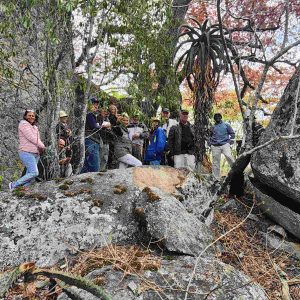
Under the Siloti Tree
Brachylaena discolor var. rotundata was a big eye-opener for me as try as I could at crushing what I thought would be a Tarchonanthus camphoratus, no camphor odour could be elicited. Was it just a non-complier or a post COVID nose? No, rather a clear, and hopefully less common, slip-up in my identification skills! But then there was Mark and Tony to the rescue. Coates Palgrave refers nicely to the loose “cobwebby” covering especially on young leaves, while the grey undersurface shares this with the wild camphor bush. The later plant was seen later in the day too and the olfactory test proved to confirm its identification. Furthermore, the now dry but dense round flower remains of Brachylaena made later identifications easy to spot.
A Zanthoxylum sp. was uncovered too. Probably Z. capense as this is the only recorded species in the area but in my admiration for the vicious curved thorns (reminding me of Tom Müller), I failed to observe the distribution of the translucent citrus glands in the leaf as Z. capense has the glands distributed only along the leaf margin whereas all other six species in Zimbabwe have the glands distributed throughout the leaf blade.
Camp Dwala had a few rock-loving Barleria albostellata in fruit. If one puts the woody seed of this plant in one’s mouth it has a moisture-absorbing trigger mechanism that creates an almost scary explosive reaction in one’s mouth, almost knocking one’s incisors out of their sockets! Very cool party trick or if you are brave enough but if concerned about false teeth then just put in a glass of water and wait a minute or two to observe the reaction. Mark indicated that this is often a feature of seeds in the Acanthaceae family.
We saw many more wonderful botanical finds but in the interest of brevity however any termination without a reflection of a paragraph in the preface of Lyn Mullin’s book would be somewhat belittling of the experience I felt being part of this trip to both the Matobo Hills and the Cycads of the Runde river. I quote from The Triumph of the Tree by JS Collis.
“We enter the wood. We leave behind the world that is so much with us – it is wholly gone………… We feel in this untrespassed calm and balk the screaming duties that are not real……… and flaunt the clock that we call time – then we too will be enlightened.”
Camp Dwala: – 3 October 2024 pm
By Stuart Wood
It was my designated task to report and the afternoon ramble, or should I say meander on our second day. Our group consisted of 12 excited botanists already to report on and record new species.
I must point out that I am new at describing how these experienced botanists go about their survey and was soon confused. Trying to understand the use of what I had always thought were dead languages – Latin, Greek, I simply could not figure out what they were talking about!
The excitement at discovering a leaf that appeared to have changed, was it a new species? What appeared to be a normal leaf revealed an unexpected abnormality. More feverish discussion in what to me was foreign language. Photos taken for discussion later. This continued involving many trees, plants, flowers, all meticulously noted and recording all this detail was beyond me.
Calmer times followed giving me time to digest all these exciting revelations of the 21/2 hour ramble in which we first advanced 300 metres and then a further 150 m which surprisingly was absolutely exhausting!!
From that far point we reluctantly drifted back to camp and a well-earned tea and home-made snacks. I am fairly confident that with a few years more experience I could more actively participate in recording these activities In the meantime let me say it was a privilege to have been a member of that knowledgeable group
Camp Dwala: The Grandmother Tree: – 4 October 2024 am
By Barbara Maasdorp Photos by members of the group
Following a visit to the ‘grandfather’ Brachystegia tree yesterday, we went to inspect the ‘grandmother’ B. tamarindoides (ex glaucescens). Although in this case the leaves were typical of B. tamarindoides there was still some speculation that it might be B. utilis or a hybrid with B. spiciformis due to its rougher bark. However, in both cases these were very old large trees, and the rough bark could have been attributed to age.
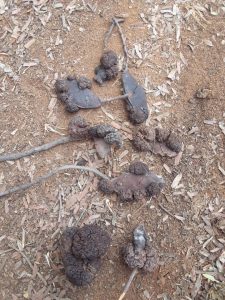
Pods and galls under
the grandmother tree
This tree was surrounded by a ‘forest’ of young offspring, unusual to be under the canopy of the mother tree. The old tree was infested with large black galls, apparently initially infesting pods as evidenced on some of the fallen pods. The ground beneath was covered with these galls and one esteemed member commented about those handling them: “Looks like you are handling sh..!” It was later pointed out that, due to orographic rain, brachystegia’s are only found on the SE side of the Matobo hills.
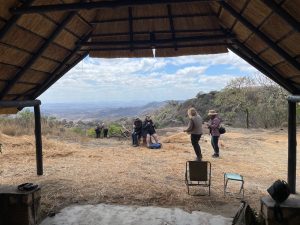
Botanists ignoring the view from the
edge of the Matobo Hills
We then drove beyond the Shumbashaba Mkulu lodge to a viewpoint, overlooking the plain below towards the Esigodini area, botanized and then enjoyed tea/coffee around the thatched gazebo.
Tree species studied were:
- Two terminalias: brachystemma (Kalahari sand terminalia) with crater-like leaf scars on the young stems and T. sericea (Silver terminalia). Typical ‘looping’ branches.
- Maytenus (now Gymnosporia) senegalensis, the confetti tree, armed with straight spines “up to 4cm”. As Tony pointed out this can be differentiated from Maytenus undata in that folding a leaf does not result in a white fold line on the upper surface.
- Commiphora marlothii, Paperbark commiphora. Characterized by a relatively dark yellowish-green bark with large pieces of peeling ‘parchment’.
- Pavetta eylesii, Flaky bark pavetta. Rubiaceae, coffee/gardenia family: simple opposite leaves and a stipule between the petioles. Usually with dark bacterial nodules. Peeling bark.
- Elephantorrhiza burkei, Elephant root. Mimosoideae family of the legumes. A shrub. In leaf and flower. Bipinnate with “4-8 pairs of pinnae” compared to goetzei with “3-41” and leaf base asymmetric in E. goetzii. Flower a white then yellow spike.
- Vangueria infausta, Wild medlar. Rubiaceae family. As Meg used to say “Vangueria is hairier” than Vangueriopsis. Leaves simple and opposite and densely hairy on both surfaces. There were very young fruit present (eventually about “2.5 – 3.5 cm in diameter”, tan coloured and edible). Vangueriopsis fruit is ovoid.
- Faurea saligna (saligna = willow-like). Noticed to have red petioles and shiny, drooping leaves with a sub-marginal vein.
- Burkea africana, Caesalpinioideae family of the legumes. A monotypic genus. Bipinnate leaves “with 1-5 pairs of pinnae each with 5-9 alternate leaflets about 3 cm long”. Old pods characteristically still on the tree after leaf fall: thin, flat and indehiscent.
Quoted information “…” from Trees of Southern Africa by K Coates Palgrave, and Common Trees of the Central Watershed Woodlands of Zimbabwe by R B Drummond, NRB.
Camp Dwala Day 2: afternoon
Text and photos by Mark Hyde
In windy weather under a leaden sky with a nippy wind (it was hard to believe this was the famous Suicide Month unless it was the cold driving us over the edge), a group of us set off from the Camp towards the separate cottage occupied by Karl and Annelie.
At this dry time of the year, there was generally little in the way of herbaceous plants, but it was on this walk that we saw most of them, particularly in one of the vleis.
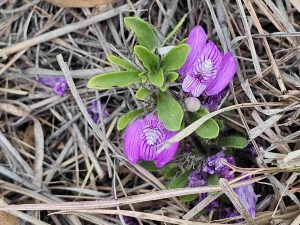
Justicia elegantula
In dry open areas were tiny depauperate plants of Justicia elegantula (Acanthaceae) consisting mostly of the bright flowers. This species is a perennial which comes up very early in the season.
Near the cottage was a cluster of interesting species, including the Matobo endemic, Gymnosporia matoboensis, the Matobo spike-thorn. This was formerly known to us as Maytenus heterophylla subsp. puberula. This was before the spiny species of Maytenus were separated off into Gymnosporia.
Maytenus heterophylla was previously a name used for a wide variety of entities many of which have been separated off as distinct species. G. matoboensis is quite similar to Gymnosporia buxifolia (another component of the former Maytenus heterophylla group), but the leaves are smaller, denser and the plants are spinier. The name Gymnosporia matoboensis was created by Marie Jordaan, relatively recently, in 2006.
Also present was Pavetta eylesii. The Pavetta is a quite widespread species in Zimbabwe but does not occur anywhere near Harare so it’s not that familiar to us. It can be recognised by its shrub or small tree-like character, i.e. it’s larger than the other widespread species such as gardeniifolia and schumanniana, and the peeling bark. It’s not special to the Matopos but it is a characteristic feature of the area.
Near to the cottage were a number of relics of cultivation, Synadenium grantii (now Euphorbia umbellata) was spreading around an adjacent ruined building, and Bauhinia variegata, the Orchid tree was showing signs of escaping, as it so readily does around Harare. As an aside, there were relatively few alien species of plant seen at Camp Dwala; the only serious invader I came across was Lantana. On the trip to the Siloti tree on the first day we travelled though fields of Lopholaena coriifolia and Helichrysum kraussii, both species characteristic of degraded soils and hence so frequently seen in Communal Lands. But both of these are native species and probably are pioneers in restoring the land.
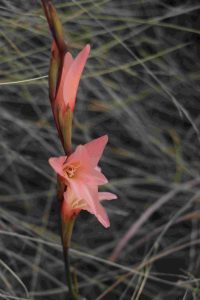
Gladiolus melleri
We also found here Kleinia barbertonica, formerly known as Senecio barbertonicus, the Barberton groundsel. This is a succulent-leaved shrub bearing numerous yellow flowers in flattened heads. As the name suggests it was first named form Barberton in Mpumalanga. It occurs in South Africa, Mozambique and Zimbabwe. It is also occasionally cultivated in Harare gardens.
Into the vlei we walked, finding several plants of the salmon-pink Gladiolus we had seen the previous day, Gladiolus melleri. This provided a splash of colour in the dark grassland of the vleis and under the dark skies.
Other species seen included species of Gnidia, Monopsis, Thesium and Gerbera.
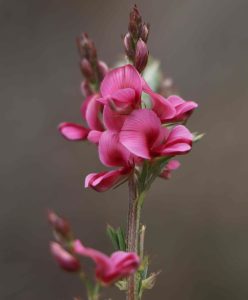
Indigofera hilaris
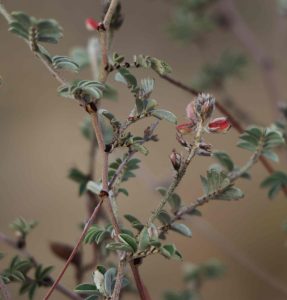
Indigofera melanadenia
Eventually we emerged from he vlei onto some bare flattish rocks near to the Stephens’ cottage and we came across two species of Indigofera. A bright pink species, probably Indigofera hilaris and nearby a new species to me Indigofera melanadenia. This species has black gland-like structures at the base of each leaflet and was a species I had never seen before.
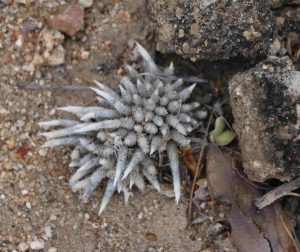
Anacampseros rhodesica,
Another unusual plant seen on this walk and elsewhere around Camp Dwala was Anacampseros rhodesica, a tiny succulent plant usually found in small hollows in bare rock. It belongs to the family Portulacaceae which mostly consist of succulent species, these often adapted to this hostile rocky environment with its huge daily temperature ranges.
In fact, another species of Anacampseros, namely subnuda, also occurs at Camp Dwala, but we did not see that one.
From there, we walked back to the Camp in the gradually darkening conditions. It was nice to be back in the warmth.
AND NOW FOR SOMETHING A BIT DIFFERENT:
OF BIRDS AND CHIRPS IN AMONG THE TREES OF CAMP DWALA AND ROCKY GLEN
By Frances Morris Photos by Frances Morris
It is common knowledge amongst Tree Society members, that our current Chair, Tony Allegria joined Tree Soc to learn the names of the trees that the birds he was observing, as the Chair of Bird Life Zimbabwe, were sitting in. Not only did he learn the names, but he transformed into one of the most knowledgeable and active members of Tree Soc. And not unexpectedly, nineteen people exploring two stunning areas of Zimbabwe observe and record more than just the flora, despite the true botanists trying to keep order. An organised Linda Hyde allocating recording duties to team members precipitated a response from me “I’ll do birds and chirps” to avoid having to dutifully record all the flora on a walk….
Big trips induce excitement, commentaries, queries, quirks and a sense of “collectiveness”, and this trip was no different, with a great pooling of decades of wilderness knowledge and discussion, sharing of notes and photos and lists. The Camp Dwala bird list was never finalised, but the final agreed list for Rocky Glen was 102, after 2 different Nightjar calls (Fiery Necked warble and Freckled yapping dog) heard on the sunset viewing rock just after the list was called.
Finding Camp Dwala proved a challenge for some, interpretations of directions were “different” with vehicles turning North at a junction instead of South, and a desire to follow a non-recommended route leading to a spectacular sunset photo of the Mzilikazi Memorial, but all vehicles finally reached our freezing venue in time for dinner. The Cape cold front arrived at the same time as we did and the next 3 days were spent regretting all the warm clothing still in our cupboards at home as the temperature never went above 15 degrees C.
The wind was biting and the birdlife ruffled, but for those of us from the North, the ever present Mocking Cliff Chats were an absolute delight, as were the Cape Batis, which invoked a lively debate on ID. In fact not much is needed due to the wing flank coloration differentiating it from the Chin Spot Batis (and a discussion on the question posted in Chirpers about the three birds whose name describes the female rather than the male of the species, the Batis being one).The Batis were obsessed with car mirrors and spent much of every day peering and pecking at Mark’s car windows and mirrors.
Another special for us was the continuous presence of the White-Throated Robin Chats in among the Kurrichane Thrushes and Dark-capped Bulbuls and Yellow-Bellied Greenbuls. The feast of Mobola plums from the giant Parinari curatellifolia in the camp ensured birds all day and bats all night. The Orange-Breasted Bush Shrike called incessantly from all around the camp and rewarded me as we were leaving with a close-up inspection. The Eastern Miombo and Scalet Chested sunbirds entertained us all as they played in the spray.
Of course, within the Matopos, the Verreaux (Black) Eagles are expected and we were rewarded with some lovely displays, and the inevitable discussion about “renaming”, a discussion that continued about much of the flora and fauna renaming for the entire trip. It is difficult to adapt to many of the names and many amateur naturalists are frustrated and increasingly confused during discussions.
One of the adventures of Camp Dwala was 04h30 alarm clocks and donning all warm gear available to ascend the hill to view Comet Tsuchinshan-ATLAS in the pre-dawn, but alas, the Cape weather front kept the horizon cloud filled and we were unsuccessful.
THEN ………
Rocky Glen proved to be a paradise for many reasons, after an adventurous journey which included glorious Brachystegia glaucescens in full flush, a cave with remarkable paintings, a wrong turn by most of the fleet, 2 blowouts on one vehicle, the warm welcome and dinner by Di Drummond soon had the group happily chirping after a dusk arrival.
The bird life as viewed from the front veranda and lawns allowed many to log “lifers”, the highlight being the Green Pigeons, the Red-Headed Weavers and the Grey-Headed Kingfisher. The Crested and Black Collared Barbets were competing with the Meve’s Starlings and Village Weavers for attention, and one member of the group spent an entire afternoon just observing the antics of the Village Weavers in the Mango tree. Yellow and Red-Billed (Southern) Hornbills hopped around the kitchen and the bird feeding zone, dominating the scene. The Green Woodhoopoes and Babblers added to the cacophony, as did the sunbirds and African Hoopoes. The first Klaas’s Cuckoo was heard but not seen.
The dam shore delight for all was the African Painted Snipe, so photogenic (and another bird whose name is derived from the female colouring). Fifty Spurwing Geese, many Egyptian Geese, Yellow-Billed Stork, Woolly-necked Stork, Common Ringed Plover, Jacanas, Squacco Heron, Green-backed Heron, Black-winged Stilt and many others created an ideal space for quiet evening sundowners and photography.
Lovely sightings of the Verreaux Eagles, the Brown Snake Eagle and the Fish Eagle added to the raptor list, and every drive had a “special sighting”. The final list call, done on top of rock dome with drinks in hand, as stated earlier, gave us 102 total, with a quip by Mark “Should we now do the 6,400 plus Flora list to record our botanical observations?”. Thankfully not, our intrepid pressing team of Mark and Cathy, assisted by Barbara (and all the cardboard from the food cartons) will give us IDs of the unknowns, and the various scribes, hand-selected by Linda will give us the final tree lists for both areas.
The combination of birds and trees and sharing “lifers” and lists gave all 19 of us a memorable 8 days, with new friendships and many stories shared, thanks to everyone for the fun and laughter and to the gurus for all we learned.
TREE SOCIETY COMMITTEE AND CONTACTS
Chairman Tony Alegria tonyalegria47@gmail.com 0772 438 697
Vice Chairman Mark Hyde mahyde@gmail.com 0772 233 751
Honorary Treasurer Bill Clarke wrc@mweb.co.zw 0772 252 720
Secretary Teig Howson teig.howson@gmail.com 0772 256 364
Venue Organiser Ann Sinclair jimandannsincs@zol.co.zw 0772 433 125
Committee Member Jan van Bel jan_vanbel@yahoo.com 0772 440 287
Committee Member Ryan Truscott ryan.kerr.truscott@gmail.co 0772 354 144
Committee Member Sibusiso Malunga busimalunga@yahoo.com 0775 889 898
Tree Life Editor Linda Hyde Lmharwin@pentact.co.zw 0772 232 075
Tree Society Website https://treesociety.org.zw/
Tree Society Facebook https://www.facebook.com/groups/ztreesociety/
Flora of Zimbabwe: https://www.zimbabweflora.co.zw/
Flora of Tropical Africa: https://plants.jstor.org/collection/FLOTA

